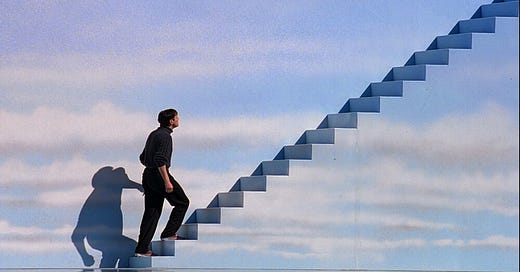The Illusion of Maya: From Vedanta to the Movie The Truman Show.
Seeing Beyond the Veil of Perception.
The new episode of the Cosmic Dancer podcast involved Lorenzo Sangalli, cinema critic and essayist, and S.A. Sreedharan, founder of Mind and Intellect Organization. Sreedharan was a student of Swami Parthasarathy at the prestigious Vedanta Academy.
Topic: Maya, illusion, in Vedanta Philosophy and the famous movie "The Truman Show".
I recently had the privilege of interviewing Lorenzo Sangalli and S.A. Sreedharan on my Vedanta philosophy podcast to explore the concept of Maya, or illusion, as revealed in Vedanta and skillfully depicted in the 1998 film The Truman Show.
Lorenzo Sangalli lent his extensive experience and insights as a longtime devotee of theatre and cinema in Milan. For over thirty years he has been immersed in the worlds of stage and screen, both as an engaged audience member and as a prolific playwright, director and producer in his own right. In addition to his creative output, Lorenzo has more recently begun lecturing and teaching on subjects related to the dramatic arts. Given his wide-ranging interests, our conversation also touched on philosophy and wisdom traditions.
S.A. Sreedharan joined us as a trained Vedanta philosopher and disciple of the eminent teacher Swami Parthasarathy. Through deep study of Vedantic texts at Swamiji's Vedanta Academy, Sreedharan has gained profound insight into these ancient teachings. He offers practical wisdom on how to apply Vedanta philosophy in navigating life's journey.
Our starting point was the 1998 film The Truman Show, starring Jim Carrey. Truman Burbank unknowingly lives his entire life as the main character in an elaborate reality TV show. The people and world around him are merely actors and sets fabricated by the show's producers to entertain the outside viewers. Truman is initially unaware that his reality is a carefully orchestrated illusion. He accepts the artifice as objective truth.
The Truman Show is a modern metaphor for the Vedantic concept of Maya. Through our limited sensory capabilities and preconceived notions, we too often mistake our perceptions of the world for reality itself. We become attached to names, forms and identities that keep us bound to this illusion. Vedanta teaches that the material world is not ultimately real. The true Reality is Brahman, the non-dual Absolute Truth. Maya is the veil that conceals this deeper unity.
Like us trapped in the illusion of Maya, Truman has an innate drive to discover the truth about his life. Strange happenings prod him to doubt the nature of his reality. He sees cracks in the artificial construct, as a spiritual aspirant starts to question their normal perception. Truman’s journey mirrors the seeker's path outlined in Vedantic texts. By following his discriminating intellect, he pierces the veil and escapes the television illusion.
Our starting point was the 1998 film The Truman Show, starring Jim Carrey. Truman Burbank unknowingly lives his entire life as the main character in an elaborate reality TV show. The people and world around him are merely actors and sets fabricated by the show's producers to entertain the outside viewers. Truman is initially unaware that his reality is a carefully orchestrated illusion. He accepts the artifice as objective truth.
The Truman Show is a modern metaphor for the Vedantic concept of Maya. Through our limited sensory capabilities and preconceived notions, we too often mistake our perceptions of the world for reality itself. We become attached to names, forms and identities that keep us bound to this illusion. Vedanta teaches that the material world is not ultimately real. The true Reality is Brahman, the non-dual Absolute Truth. Maya is the veil that conceals this deeper unity.
Like us trapped in the illusion of Maya, Truman has an innate drive to discover the truth about his life. Strange happenings prod him to doubt the nature of his reality. He sees cracks in the artificial construct, as a spiritual aspirant starts to question their normal perception. Truman’s journey mirrors the seeker's path outlined in Vedantic texts. By following his discriminating intellect, he pierces the veil and escapes the television illusion.
The parallels to Vedantic enlightenment are striking. Having torn down the barriers of Maya, Truman realizes his nature is not defined by any false identities or labels. He attains freedom not by destroying the world, but by seeing through it. This reflects the teaching that our bondage stems from perception, not the world itself. The path to enlightenment thus lies inward, not outward.
Both Vedanta and this profound film reveal that expanding consciousness is the key to freedom. When we open our minds, question limitations, and discard false identities, we can begin to know ourselves and perceive reality as it truly is. Constructs keeping us from recognizing our divine nature dissolve.
It was a privilege to explore this rich philosophical ground with two esteemed guests, made possible by you, the listeners of my Vedanta podcast. Your abiding interest motivates me to continue these meaningful dialogues aimed at uncovering Vedanta's timeless wisdom. I hope you found this episode insightful. Stay tuned for more as we connect eternal truths to contemporary life. Please reach out with feedback or suggestions for future topics to cover. I appreciate your support on this never-ending journey of discovery.
I have woven tales to share, for any who care to read them. My books await you on Google Books. Check also my stories on Medium.com.
I would be honoured if you considered subscribing to the Premium Contents of my Vedanta Substack and leaving feedback, comments, and suggestions both on this page and by writing to me at cosmicdancerpodcast@gmail.com.
Thank you for your precious attention.




